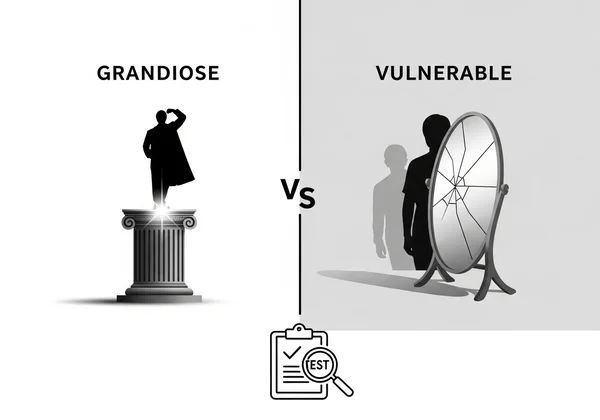Grandiose & Vulnerable NPD: Unpacking Narcissistic Types
Have you ever encountered someone who seemed incredibly self-absorbed but also surprisingly fragile? Or perhaps someone who craved attention loudly, yet another who subtly manipulated situations to their advantage? Narcissistic Personality Disorder (NPD) isn't a one-size-fits-all diagnosis. Many people wonder, what are the different types of npd? This article delves into the "two faces" of narcissism – the overt grandiose narcissist and the often-missed vulnerable narcissist – helping you identify and understand these nuanced behaviors, whether in yourself or others. If you're seeking to understand these complex patterns, you can gain clarity with a free test on our site.

This guide will help you look beyond the stereotypes. Understanding these subtypes is the first step toward gaining a clearer perspective on your relationships and your own internal world. It’s about replacing confusion with knowledge and finding a path forward.
The Grandiose Narcissist: Overt Power & Entitlement
When most people picture a narcissist, they often imagine the grandiose type. This is the classic, overt presentation of narcissism characterized by an inflated sense of self-importance, a need for constant admiration, and a visible lack of empathy for others. They are often charismatic, ambitious, and socially dominant, using their confidence to charm and command attention.
Individuals with grandiose narcissistic traits genuinely believe they are superior. They see themselves as special, unique, and deserving of the best of everything. This isn't just an act; it's a core belief that drives their behavior. They will often boast about their achievements, exaggerate their talents, and expect others to recognize their supposed brilliance without question. How do you check if you have NPD? Recognizing these overt patterns is often the first clue, though a comprehensive official NPD test can offer more structured insight.
Classic Traits of Overt Narcissism
The behaviors of a grandiose narcissist are typically easy to spot because they are externalized. They aren't trying to hide their self-perception; they want the world to see it. Some of the most common traits include:
- Arrogance and Dominance: They often dominate conversations, interrupt others, and dismiss opinions that conflict with their own.
- Sense of Entitlement: They have unreasonable expectations of especially favorable treatment and automatic compliance with their wishes.
- Exploitative Behavior: They are not afraid to use others to achieve their own ends, often without remorse.
- Preoccupation with Success: They fantasize about unlimited success, power, beauty, or ideal love, feeling they are destined for greatness.
- Need for Admiration: They require excessive praise and attention, feeling slighted or angry when it's not provided.
The Quest for Admiration & Status
At its core, the grandiose narcissist's behavior is fueled by a relentless quest for external validation. Their self-esteem, though appearing high, is often brittle and dependent on the admiration of others. They seek out positions of power, accumulate status symbols, and surround themselves with people who will feed their ego. This pursuit of status isn't just about success; it's about proving their superiority to themselves and the world, reinforcing the grandiose self-image they have constructed.

Unmasking the Vulnerable Narcissist: Covert Insecurity
In stark contrast to the grandiose type, the vulnerable narcissist (also known as a covert narcissist) is often overlooked. Their narcissism is masked by a veneer of shyness, victimhood, or even humility. While they harbor the same feelings of entitlement and self-importance, these beliefs are rooted in deep-seated insecurity and a fragile sense of self. They don't openly boast; instead, they manipulate from the shadows.
A vulnerable narcissist is hypersensitive to criticism and constantly feels slighted by others. They believe they are special and misunderstood, and they resent the world for not recognizing their unique talents and sensitivities. This internal conflict between their sense of entitlement and their profound insecurity creates a pattern of passive-aggressive behavior, emotional fragility, and a tendency to see themselves as a perpetual victim. If you are struggling to understand such complex behaviors in someone you know, a confidential test for npd can be a valuable first step in organizing your thoughts.
Subtle Signs of Covert Narcissism in Action
Recognizing a vulnerable narcissist requires looking for more subtle clues. Their actions are often contradictory, blending a quiet sense of superiority with apparent insecurity. Key covert narcissism signs include:
- Hypersensitivity to Criticism: Even mild feedback can be perceived as a major personal attack, leading to withdrawal or passive-aggressive retaliation.
- Victim Mentality: They frequently frame themselves as the victim in any situation, blaming others for their failures and misfortunes.
- Quiet Smugness: While not overtly arrogant, they may display a subtle air of superiority, implying they are more intelligent or sensitive than those around them.
- Social Withdrawal: They may avoid social situations where they don't feel they can shine or control the narrative, fearing judgment or failure.
Hidden Insecurities, Envy, & Passive Aggression
The inner world of the vulnerable narcissist is tumultuous. It is defined by hidden insecurities, envy, and passive aggression. They are intensely envious of others' successes because it highlights their own perceived shortcomings. However, instead of competing openly like a grandiose narcissist might, they are more likely to undermine the person they envy through subtle digs, gossip, or withholding support. Their anger isn't explosive; it simmers beneath the surface and emerges as sulking, giving the silent treatment, or making backhanded compliments. This behavior is a defense mechanism designed to protect their fragile ego from further injury.

Grandiose vs. Vulnerable: Key Distinctions & Overlaps
While both subtypes share core narcissistic traits like entitlement and a lack of empathy, their expression and underlying motivations are profoundly different. Understanding the types of npd is crucial for accurate identification. The grandiose narcissist's engine runs on admiration, while the vulnerable narcissist's runs on a fear of criticism and a need for sympathy.
A simple way to conceptualize the difference is through their approach to self-esteem regulation. The grandiose narcissist regulates their self-esteem by actively seeking external praise (an offensive strategy), while the vulnerable narcissist regulates it by defending against perceived threats and slights (a defensive strategy). Exploring these patterns through a structured format can help clarify whether certain behaviors align with narcissistic traits. You can explore these traits further on our homepage.
Comparing Behavioral Patterns & Core Motivations
Here’s a quick comparison to highlight the key differences:
| Characteristic | Grandiose (Overt) Narcissist | Vulnerable (Covert) Narcissist |
|---|---|---|
| Self-Esteem | Outwardly high, bold, and resilient | Fluctuating, fragile, and defensive |
| Social Style | Extroverted, charming, and dominant | Introverted, anxious, and withdrawn |
| Reaction to Criticism | Becomes angry, dismissive, or retaliates | Feels shame, becomes withdrawn, or passive-aggressive |
| Primary Motivation | To gain admiration and prove superiority | To avoid criticism and gain sympathy |
| Emotional Expression | Expresses anger and rage openly | Expresses shame, envy, and victimhood |
Why Understanding These Subtypes Is Crucial
Recognizing that narcissism can be both loud and quiet is essential. Misidentifying a vulnerable narcissist as merely shy or sensitive can lead to prolonged confusion and emotional distress in relationships. Similarly, understanding the motivations of a grandiose narcissist can help in setting boundaries and protecting oneself from exploitation. This nuanced understanding allows for more effective coping strategies and a clearer assessment of interpersonal dynamics. It provides the context needed to make sense of otherwise baffling behavior.

Beyond Stereotypes: Gaining Deeper Clarity on NPD
Narcissistic Personality Disorder is far more complex than the stereotype of a loud, arrogant individual. It exists on a spectrum and manifests in diverse ways, from the overtly grandiose to the covertly vulnerable. By understanding these two primary subtypes, you can better navigate challenging relationships and gain deeper insight into your own behavioral patterns.
Knowledge is the first step toward clarity. If this article has resonated with you, whether through self-recognition or in identifying the behavior of someone you know, further exploration may be beneficial. Remember, this information is for educational purposes and is not a substitute for a professional diagnosis. Take our confidential NPD test to receive a preliminary, private screening based on DSM-5-TR standards and start your journey toward greater self-awareness.
Frequently Asked Questions About Narcissistic Subtypes
What are the 9 diagnostic signs of NPD, and do they apply to both types?
Yes, the nine diagnostic criteria for NPD outlined in the DSM-5 apply to both subtypes, though they manifest differently. These signs include a sense of grandiosity, a preoccupation with fantasies of success, a belief in one's specialness, a need for excessive admiration, a sense of entitlement, exploitative behavior, a lack of empathy, envy of others, and arrogant behaviors. A grandiose narcissist might display these overtly, while a vulnerable narcissist's entitlement and grandiosity are often hidden behind a facade of insecurity.
How do I tell if someone I know exhibits covert narcissistic traits?
Look for patterns of hypersensitivity, a persistent victim mentality, and passive-aggressive behavior. They may often complain about being misunderstood or underappreciated and react with intense shame or resentment to even gentle feedback. They may also subtly devalue others' accomplishments out of envy. Using our screening tool can provide a structured way to consider these traits, but it's important to remember it is not a diagnostic instrument for others.
Can a person display traits of both grandiose and vulnerable narcissism?
Absolutely. While one type is often more dominant, individuals can fluctuate between grandiose and vulnerable states. For example, a person who is typically grandiose may collapse into a vulnerable state of shame and self-pity after a major failure or public humiliation. This fluctuation makes understanding the full spectrum of narcissistic expression even more important.